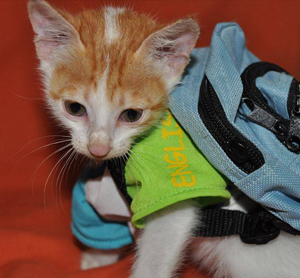
After a summer full of fun and time off, the first day of school is often bittersweet. For many families, back-to-school time is action packed: meeting new teachers, buying new clothes, and making sure all of the necessary school supplies are checked off of this year’s list. With lunches packed, a first-day-of-school picture snapped, and (possibly) a few tears, the kids are out in a flash. But what about the family pet? What do they feel in the midst of the commotion, schedule changes, and loss of their playtime pal? The truth is, it can be quite traumatic.
Signs that Your Pet is Struggling
 | When animals are under stress or under stimulated, they tend to exhibit unusual or exaggerated behaviors. Separation anxiety usually results in telltale signs that include accidents, chewing of household items, excessive barking, scratching, panting, pacing, whining, disobeying comfortable commands, or waiting by the doors or windows for extended periods of time. In more extreme cases, pets may try to find or follow their absent companions, which can lead to fence jumping, digging out, or running off. Times like these make it even more crucial that your pets are wearing ID tags with updated contact information. |
Step 1: Calming Their Stress
One of the first things you can try is to ease your pet into alone time. Instead of surprising them with your or your child’s sudden, prolonged absence on the first day of school, start spending time away from home in small increments. This way they can get used to not having their loved ones around all of the time. Also, leaving a used t-shirt or blanket with familiar smells may comfort them while you are gone.
Step 2: New Toys and Distractions
 | Who doesn’t love a new gadget to play with? Dogs, cats, hamsters, guinea pigs, and many other pets love to be entertained. If you think your pet’s anxiety is a result of boredom, try giving them a new toy. Dogs tend to enjoy bones or toys that involve treat rewards, especially ones that challenge them. Cats have a great time with scratching boards or items they can safely climb on, toy mice they can playfully "hunt," as well as peek-a-boo style games. You can also leave the television or radio on to comfort pets that are used to hearing family chatter. |
Step 3: Reward Good Behavior
Try to make departures and arrivals as calm and positive as possible. Giving a treat before you leave the house and when you get home is an excellent place to start. This may help your pet look forward to these times of day instead of dreading them.
Step 4: Lots of Play
 | One of the most common reasons for destructive behavior is a lack of exercise or stimulation, especially if your pet has just spent the summer running around and playing with the kids. As a substitute, introducing your pet to new animal friends, training classes, or day care can be very helpful. Well, at least until the end of the school day, when their best friend comes home again. |
| A back to school idea for the whole family: Pet ID tags also make great name tags for backpacks and keychains. Just as a dog tag contains important information about your pet in the event they get lost, the same goes for your own personal items. We have hundreds of designs that look great on humans too! |

